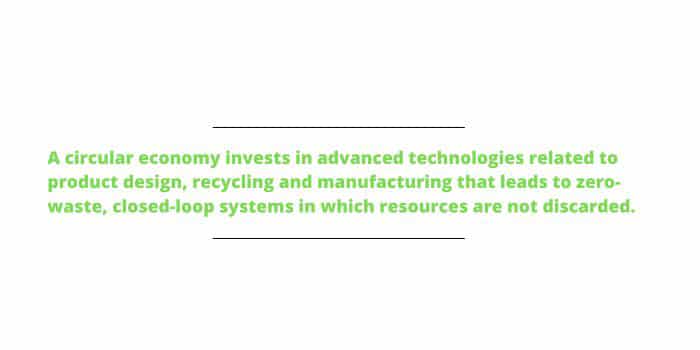In promo, we say that product responsibility is everyone’s job. And increasingly, our work doesn’t end when handing off merchandise to the end user.
Extended Producer Responsibility is a growing policy approach that assigns producers and importers significant new responsibility for the treatment or disposal of products at the end of their life cycle. That responsibility includes financial and physical concerns. EPR is also described as a method to identify the various environmental impacts relevant to a product’s entire life cycle, including its packaging.
The driving factor for many of these policies is the goal of moving away from a linear economy, which entails taking, making, consuming and disposing of resources. Governments are instead seeking a circular economy that invests in advanced technologies related to product design, recycling and manufacturing that leads to zero-waste, closed-loop systems in which resources are not discarded. The elements of a closed loop entail production, usage, reduction, recycling and reuse.
The model prioritizes products that are made to be made again.

Legislation To Follow
In the U.S., most of the movement on EPR policies is coming from out west. Numerous states have enacted laws addressing end-of-life concerns for consumer products and packaging. Some others are updating preexisting laws, while several are considering new approaches.
For example, California’s Senate Bill 54, which passed in 2022, implements what could be the country’s most ambitious state-mandated paper and plastic recycling requirements. Under SB 54, plastic packaging in the state must be recyclable or compostable by 2032.
Some of the legislation’s requirements start earlier: There is a 30% threshold for plastic packaging in California to be recycled by January 1, 2028, with increases to 40% by 2030. California’s goal is for this policy to achieve a net reduction of plastic packaging waste by 25% within a decade.
California’s EPR legislation applies to just about any company that handles consumer or commercial goods, including manufacturers and direct sellers. SB 54 also requires producers of covered materials to join a producer responsibility organization (or PRO) by January 1, 2024. The purpose of the group is to manage businesses’ activities to comply with SB 54’s requirements. The PRO will develop plans for the collection, processing and source reduction of materials covered by SB 54. The methods prescribed by the state government to enforce SB 54’s mandates are similar to other compliance-related requirements, including reporting, recordkeeping, registration and auditing.
Although California’s EPR legislation may be regarded as the most comprehensive in the U.S., it is certainly not the only policy addressing end-of-life concerns for products and packaging.
In 2022, Colorado passed the Producer Responsibility Program for Statewide Recycling Act. This law also establishes a PRO to manage the state’s recycling program. These state-mandated memberships are the method for shifting the costs of recycling programs and other government efforts to create circular economies. Colorado’s Department of Public Health and the Environment will oversee the administration of the state’s PRO, including the creation of a statewide list of recyclable items.
Oregon has a similar law that went into effect in 2022. The law embodies the same concept of shifting responsibility for the costs of recycling and closed-loop initiatives to producers. The Plastic Pollution and Recycling Modernization Act expands public access to recycling services and upgrades the state’s recycling facilities, among other goals. The new law’s requirements take effect in 2025.
Gaining Momentum
The West Coast is not the only region that has implemented state-level requirements regarding end-of-life concerns for consumer products.
In 2021, Maine’s legislature enacted a law that created what the state is calling a stewardship program. Maine’s EPR law establishes an organization to implement the stewardship program under the oversight of the state’s Department of Environmental Protection. This arrangement is similar to the western states’ PROs, with the same funding mechanism.
Massachusetts also expanded its waste disposal ban in 2022 by adding textiles to the list of covered materials and lowering the threshold for food waste to trigger the law’s requirements. As of November 2022, facilities generating more than one half-ton of organic or food waste per week are covered by the disposal ban. There is an exception; some contaminated textiles are exempt from the waste disposal ban’s enforcement.
In addition to existing laws, two dozen states have proposed new EPR policies in 2023 alone. Some are creating new mandates, while others are expanding on existing requirements.
Complying with these demands will likely require an approach similar to methods for adhering to other laws our industry has dealt with before. The Consumer Product Safety Improvement Act and the Toxic Substances Control Act, among others, taught us the importance of recordkeeping, reporting, registration and other solutions.
Needless to say, distributors and suppliers need to be prepared.
Norris is the public affairs manager at PPAI.


